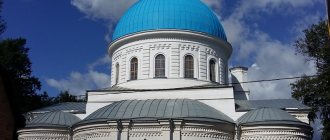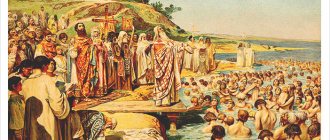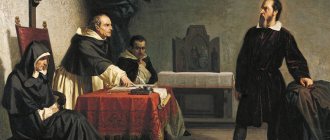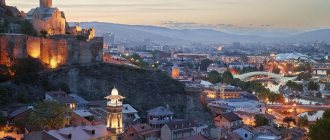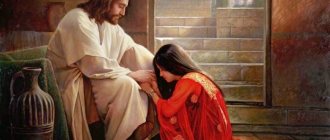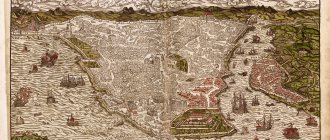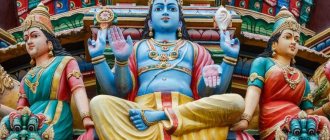Viy is not just a character invented by Nikolai Vasilyevich Gogol. The creepy creature was considered one of the heirs of Chernobog, the supreme dark god of the pagans. What do we really know about the pagan gods?
The pagan Slavic pantheon, like any other, is a strict hierarchy. There are both progenitor gods and minor semi-divine beings here. The different hypostases of the main god and complex family ties can easily confuse an unprepared person. For the ancient Slavs, everything was simple.
What gods did people worship before the baptism of Rus', and who does the Slavic pantheon of pagans include? Factrum has compiled a list of the most powerful pagan gods of the ancient Slavs.
Religion of the ancient Slavs: the formation of Slavic paganism
The most ancient religious views originated among the Slavic peoples about 2-3 thousand years ago. At first, people developed the belief that every person, thing, animal or natural phenomenon has a soul. The belief in disembodied doubles and the deification of natural forces was called animism. Later, the spiritual culture of the Slavs was replenished with totemic beliefs. The objects of worship were images of sacred animals: bear, wild boar, elk. Thus, each animal became a symbol of some Slavic deity. There were also plant symbols of faith. Many sacred rituals were performed near isolated birch, willow or oak trees.
So, answering the question “What was the religion of the ancient Slavs in ancient times?”, we can safely say that they professed paganism and describe it as polytheism.
This is interesting!
It was believed that every Slav was originally of divine origin. Therefore, people honored their Great Ancestors in every possible way.
1.1. Religion of the Western Slavs
The ancient tribes of the Western Slavs considered some animal to be their ancestor. This animal was declared sacred and various rituals were dedicated to it. The gods of the Western Slavs were almost no different from the deities of their eastern and southern counterparts. For example, the god Perun was better known as Perkunas. Although each tribe revered the patron idol of its own community. The Western Slavs did not have open sanctuaries. They built temples - pagan temples, where all the idols were located. Only the Magi could enter the temple.
1.2. Religion of the South Slavs
The spiritual beliefs of the southern Slavs were fundamentally different from the beliefs of eastern and western peoples. The main symbol for them was the image of a snake. The snake represented a supernatural force that commands natural phenomena.
This is interesting!
The South Slavs believed that animals were once people, but because of the sins they committed, they turned into beasts. Therefore, all animals cannot speak, but understand human language and feelings.
The Legend of the Choice of Faith
In 980, Prince Vladimir won the war of succession and established himself on the Kiev table. Then he made an attempt to create his own pantheon of pagan gods - Vladimir’s temple. This didn't have much effect. People continued to worship their old gods.
According to the Tale of Bygone Years, all confessions sent their envoys to Prince Vladimir.
Mohammedans
The first were Muslims from Volga Bulgaria. They exhorted the ruler of Rus' to accept Islam, promising the caresses of the beautiful Gurias in the afterlife. But strict restrictions on food and drink (no pork and wine) and the need to undergo circumcision turned out to be unacceptable. The chronicle quotes Prince Vladimir as follows:
“Rus' drinks joy, we cannot live without it”
Catholics (Latins)
Next came the envoys of the Pope (Germans from Rome […] messages from the Pope”). It should be noted that the final, Great Schism into the Roman Catholic Church in the West and the Orthodox Church in the East, centered in Constantinople, occurred later in 1054. But already at the end of the 10th century, these were actually two churches opposing themselves to each other. Obviously, this was not the first visit of Christians of the Western rite to Rus'. The prince’s refusal is recorded in the chronicle as follows:
“Go again, because our fathers did not accept the essence of this”
Jews
Having learned about the failure of their predecessors, Jews from the Khazar Kaganate (Jewish kozarstiya) arrived in Kyiv. The attempt was obviously a failure, because it was the vanquished who accepted the religion of the victors, and not vice versa. And the Kaganate collapsed under the blows of the Russians. Vladimir's father Svyatoslav not long ago devastated Khazaria. Vladimir himself fought with them in 985 and imposed tribute on them. The prince asked the Jews where their lands were. They answered that God was angry with them and scattered them among the nations. Vladimir was indignant: how can they teach others if they themselves are rejected by God. Or do they want the same fate for his people?
Orthodox
In contrast to the delegations of other faiths, the Byzantine priest is shown as a lonely philosopher. But he captivated the prince with a retelling of the Old and New Testaments, answered all questions about faith and amazed him with his eloquence. The philosopher also showed Vladimir a colorful picture of the Last Judgment.
“Good for the righteous, woe for the sinners!” - said the prince.
“Be baptized, and you will be in heaven with the first,” answered the Greek preacher.
Religion of the Eastern Slavs before the adoption of Christianity
The system of pre-Christian ideas about the world and man among the ancient Eastern Slavs was based on mythology and magic. At an early stage of development, Slavic paganism was characterized by dualism. People believed in the existence of good and evil spirits. A pantheon of Slavic pagan deities gradually formed.
Each God personified a certain natural element, a reflection of social relations or rituals characteristic of a particular period. The main group was the group of higher Gods, where there were such characters as: Perun, Horse, Veles, Svarog, Makosh and Lada. The Eastern Slavs of the pagan period held services in special places - temples, where they presented gifts and sacrifices to the Gods. And the Eastern Slavic peoples divided the extraterrestrial abode of the human soul into heaven and hell.
An important place in the religion of the Eastern Slavs was occupied by the cult of ancestors, who protected the clan from dangers and evil spirits. There was also an annual cycle of agricultural holidays; people believed in omens and told fortunes.
Reference!
The religion of the Eastern Slavs, which occupied an important place in the life of every person of that time, before the baptism of Rus', was paganism.
As the ancient Russian state formed, ties between Rus' and Byzantium and other states began to develop stronger. Ancient paganism began to be subject to doubt, and its adherents began to be persecuted or taught. In 988, the baptism of Rus' took place, Christianity became the official religion and paganism was practically supplanted.
Spreading knowledge about religion
The Kiev throne came into the possession of Yaroslav the Wise, who was also the son of Vladimir. The new prince sought to enlighten the Russian people and strengthen the Christian faith. Yaroslav had great authority in his homeland and in European countries; he wanted to raise the status of Rus' to the level of the brilliant Byzantium.
The educational mission was extremely important for the young culture of the Russian people . Knowing that the country could become morally isolated and wild if it continued to stay away from spiritual centers, Yaroslav the Wise established relations with states that had a rich experience of religiosity.
- The prince received foreign Christian ambassadors in his chambers and sought to adopt the best customs. He diligently distributed spiritual literature.
- Greek, Bulgarian and Serbian clergy came to domestic monasteries, bringing church utensils, ancient writings, books on worship, which they soon began to translate.
- In Rus', the position of scribe appeared, whose job was to census the Sacred Texts. Christianity became a zealous educator of the Russian people, people were taught to read and write everywhere.
- Prince Yaroslav founded a large library in which everyone could find the necessary theological knowledge. The ruler gave priests aids for preaching and created Sunday schools.
- The prince created a moral Charter, in which the reader found legislation for moral behavior. The Russian people, studying Christianity, changed their own vision and rethought their attitude towards good and evil.
- His son Svyatoslav II continued his father’s work and published a religious “Izbornik”, which contained excerpts from the works of the Ecumenical Teachers, Augustine, John of Damascus and others.
In Rus', the position of scribe appeared, whose job was to census the Sacred Texts
Religion of the Eastern Slavs: holidays and rituals, cults
All holidays in the calendar of the Eastern Slavs were closely connected with the seasons, natural phenomena and the cult of ancestors.
There were many holidays, rituals and ceremonies associated with the worship of deities in honor of the main points of the agricultural calendar. Many of the pagan holidays exist among the Slavs to this day; they are closely intertwined with Christian traditions. These are holidays such as:
- Kolyada - winter solstice day;
- Maslenitsa is a holiday of farewell to winter and welcoming of spring;
- Ivan Kupala - summer solstice;
In addition to holidays, the agrarian cult of the Eastern Slavs included many rituals and ceremonies aimed at predicting and increasing the future harvest. While plowing the field, people read special spells for a rich harvest, usually they were addressed to the goddess Lele.
The cult of ancestors was also significant in the religion of ancient Slavic unity. Historians consider the performance of rituals over dead people, the performance of Trizna and other traditions to be manifestations of this cult.
3.1. Calendar holidays
Among the Eastern Slavs, every season deserved a celebration, because the beginning of the season influenced the carrying out of agricultural work and the performance of rituals aimed at strengthening love, friendship, and family well-being. On the winter holiday of Kolyada, people praised God, who brought knowledge to people. In Kudesy it was customary to place gifts for the guardian spirit of the house. At the beginning of spring, the invocation of spring and Maslenitsa were celebrated. There were many holidays in the summer: Bathing Suit, Snake Day, Veles Sheaf Day.
3.2. Wedding customs and rituals
Shortly before the celebration, the bride and groom visited the graves of their deceased relatives in order to receive their blessing. This action was important for the feeling of interaction with the Family Tree. A sorcerer or priest was invited to the wedding, who solemnly united the couple into a union. The Magus addressed solemn speeches to the supreme Gods: Lada, Triglav and Rod. Weddings were held in the lap of nature, the newlyweds wore homespun clothes decorated with embroidery. The wedding ceremony was held near a sacred tree, usually a birch. The young people walked around the tree three times; this ritual symbolized the sun, unity and infinity of life.
3.3. Funeral rites
The burial rite of the ancient Slavs had two important goals: to create a connection between the world of living people and the dead, to properly equip the deceased for the long journey to the kingdom of the departed. The ancient Slavs buried their dead by burying them in the ground or cremating them. In most rituals, a fire burned, because the Slavs were fire worshipers. The urn containing the ashes was then placed in the family mound. At funerals, all Eastern Slavs had ritual food - kutia, jelly and pancakes. On the days of remembrance of the dead, a bathhouse was heated for them, candles and bonfires were lit, and food was prepared. This was done with the aim of appeasing the ancestors, who could protect the family, or could cause harm.
This is interesting!
Most often, people were cremated in boats. There was a belief that in order to get to another world, the soul had to cross the river.
3.4. Rite of Name-Naming
The ritual performed by the Magi had the goal of giving a person a Slavic name and opening the flow of energies associated with him. Naming could give two names: one – secret, the other – obvious. A secret name was given in order to protect a person from the action of otherworldly evil forces. An explicit name could denote the bright decisive qualities of its owner: Buyan, Ratibor, Iskren. Or, on the contrary, testify to the parents’ desire to give the child a calm and peaceful disposition: Golub, We love, Veleslav.
3.5. The rite of tonsure
Children aged five to seven years old were subjected to the rite of tonsure. This was a sign of the transition from the guardianship of the mother to the guardianship of the father, the opportunity to fill the child with the possibilities received from the Gods. The tonsured child was seated near an object associated with a male or female field of activity and his hair was cut in a cross shape. The ritual was performed in the morning, in sunny weather, in the presence of parents, relatives, musicians and wise men.
3.6. Ceremonies for starting house construction
It was strictly forbidden to build a house in the place of a bathhouse or cemetery, or on a road, even an old and abandoned one. First of all, the owner placed 4 stones in the corners of the future hut, and a small tree was temporarily planted in the center. After this, a sacrifice was made to the Gods. At first it could be a chicken or a goat, and then they became symbols of wealth: bags of wool, grain and coins. Under the first crown of four logs, amulets were placed in the corners - incense, coins, animal hair. Pebbles with painted protective symbols were hidden under the threshold.
3.7. Ritual of the Trizna
Trizna was understood as a ritual performed in honor of glorifying a deceased worthy person. To carry out the deceased, the wall in the house was dismantled so that in the future the deceased would not disturb the living inhabitants of the house. A large fire was made in front of the house, on which the deceased was burned. In memory of the deceased, the Slavic community held various competitions and memorial events with drinking honey, jelly and the presence of funeral dishes. It was customary to cry loudly over the grave of the deceased; female mourners were even specially invited for this purpose.
New in blogs
Paganism is the oldest religion on Earth. It has absorbed thousands of years of wisdom, knowledge, history, and culture. In our time, pagans are those who profess the old faith that existed before the advent of Christianity. And, for example, among the ancient Jews all beliefs that did not recognize Yahweh or refused to follow his law were considered pagan religions.
The ancient Roman legions conquered the peoples of the Middle East, Europe and North Africa. At the same time, these were victories over local beliefs. These religions of other peoples, “languages” were called pagan. They were given the right to exist in accordance with the interests of the Roman state. But with the emergence of Christianity, the very religion of Ancient Rome with the cult of Jupiter was recognized as pagan...
As for ancient Russian polytheism, the attitude towards it after the adoption of Christianity was militant. This is stated by many historical facts. The new religion was contrasted with the old one as true - untrue, as useful - harmful. This attitude excluded tolerance and assumed the eradication of pre-Christian traditions, customs, and rituals. Christians did not want their descendants to remain signs of the “delusion” to which they had hitherto indulged. Everything that was in one way or another connected with Russian beliefs was persecuted: “demonic games”, “evil spirits”, sorcery.
Even the image of an ascetic “non-fighter” arose, who dedicated his life not to feats of arms on the battlefield, but to the persecution and destruction of “dark forces.” New Christians in all countries were distinguished by such zeal. But if in Greece or Italy time saved at least a small number of ancient marble sculptures, then Ancient Rus' stood among forests. And the Tsar Fire, raging, did not spare anything: neither human dwellings, nor temples, nor wooden images of gods, nor information about them written in Slavic carvings on wooden tablets.
And only quiet echoes have reached our days from the depths of the pagan world. And it is beautiful, this world! Among the amazing deities that our ancestors worshiped, there are no repulsive, ugly, disgusting ones. There are evil, scary, incomprehensible ones, but there are much more beautiful, mysterious, kind ones. The Slavic gods were formidable, but fair and kind. Perun struck villains with lightning. Lada patronized lovers. Chur protected the boundaries of his possessions. Veles was the personification of the master's wisdom, and was also the patron of hunting prey.
The religion of the ancient Slavs was the deification of the forces of nature. The pantheon of gods was associated with the performance of certain economic functions: agriculture, cattle breeding, beekeeping, crafts, trade, hunting, etc. And one should not assume that paganism is just the worship of idols.
After all, even Muslims continue to bow to the black stone of the Kaaba - the shrine of Islam. For Christians, this is represented by countless crosses, icons and relics of saints. And who counted how much blood was shed and lives given for the liberation of the Holy Sepulcher in the Crusades? Here is a real Christian idol, along with bloody sacrifices. And burning incense and lighting a candle is the same sacrifice, only taking on a beautiful appearance. The popular idea of the extremely low level of cultural development of “barbarians” is not confirmed by historical facts. The products of ancient Russian stone and wood carvers, tools, jewelry, epics and songs could only appear on the basis of a highly developed cultural tradition. The beliefs of the ancient Slavs were not a “delusion” of our ancestors, reflecting the “primitivism” of their thinking. Polytheism is the religious belief of not only the Slavs, but also of most peoples. It was typical of Ancient Egypt, Greece, Rome, whose culture could not be called barbaric. The beliefs of the ancient Slavs were not much different from the beliefs of other peoples, and these differences were determined by the specifics of their way of life and economic activity.
At the end of the 80s of the last century, the Soviet government, living its last days, decided to celebrate the 1000th anniversary of the baptism of Rus'. How many shouts of welcome were heard: “1000th anniversary of Russian writing!”, “1000th anniversary of Russian culture!”, “1000th anniversary of Russian statehood!” But the Russian state existed even before the adoption of Christianity! It is not for nothing that the Scandinavian name of Rus' sounds like Gardarika - the country of cities. Arab historians also write about the same thing, numbering Russian cities in the hundreds. At the same time, claiming that in Byzantium itself there are only five cities, the rest are “fortified fortresses.” And the Arab chronicles called the Russian princes Khakans, “Khakan-Rus”. Hakan is an imperial title! “Ar-Rus is the name of a state, not a people or a city,” writes the Arabic author. Western chroniclers called the Russian princes “kings of the people of Ros.” Only the arrogant Byzantium did not recognize the royal dignity of the rulers of Rus', but it did not recognize it either for the Orthodox kings of Bulgaria, or for the Christian emperor of the Holy Roman Empire of the German nation, Otto, or for the emir of Muslim Egypt.
The inhabitants of Eastern Rome knew only one king - their emperor. But even the Russian squads nailed a shield to the gates of Constantinople. And, by the way, Persian and Arab chronicles testify that the Rus make “excellent swords” and import them into the lands of the caliphs. That is, the Rus sold not only furs, honey, wax, but also the products of their artisans. And they found demand even in the land of damask blades. Another export item was chain mail. They were called “wonderful” and “excellent.” Technology, therefore, in pagan Rus' was no lower than the world level. Some blades from that era have survived to this day. They bear the names of Russian blacksmiths - “Lyudota” and “Slavimir”. And this is worth paying attention to. This means that the pagan blacksmiths were literate! This is the level of culture.
Next point. The calculation of the formula for the world's rotation (Kolo) allowed the pagans to build ring-shaped metal sanctuaries, where they created the most ancient astronomical calendars. The Slavs determined the length of the year at 365, 242, 197 days. The accuracy is unique! And in the commentary to the Vedas, the location of the constellations is mentioned, attributed by modern astronomy to 10,000 years BC. According to biblical chronology, even Adam was not created at this time. The cosmic knowledge of the pagans has advanced quite far. Evidence of this is the myth of the cosmic vortex Stribog. And this is consistent with the theory of the origin of life on Earth - the panspermia hypothesis. Its essence boils down to the fact that life did not arise on Earth on its own, but was brought in by a purposeful stream with spores, from which the diversity of the living world later developed.
It is these facts that are the indicators by which the level of culture and education of the pagan Slavs should be judged. And no matter what adherents of Orthodoxy claim, Christianity is an alien, foreign religion that paved its way in Rus' with fire and sword. Much has been written about the violent nature of the baptism of Rus', not by militant atheists, but by church historians.
(1169. Militant Christians under the leadership of Bishop Absalon destroy the statue of the god Svetovit in Arkon.) And one should not assume that the population of the Russian lands resignedly accepted the command of the apostate Vladimir.
People refused to come to the river bank, left the cities, and started uprisings. And the pagans were by no means hiding in distant forests - a century after the baptism, the Magi appeared in large cities. But the population did not experience any hostility towards them, and either listened to them with interest (Kyiv), or completely willingly followed them (Novgorod and the Upper Volga region).
(Slavic sorcerer) Christianity was never able to completely eradicate paganism.
People did not accept alien faith and performed pagan rituals. They made sacrifices to the waterman - they drowned a horse, or a beehive, or a black rooster; to the devil - they left a horse or at least a buttered pancake or egg in the forest; to the brownie - they put a bowl of milk and swept the corners with a broom soaked in rooster's blood. And they believed that if the sign of the cross or prayer did not help against annoying evil spirits, then swearing, which originated from pagan spells, would help. By the way, two birch bark letters were found in Novgorod. They contain, at least, a single swear verb and an “affectionate” definition addressed to a certain Novgorod woman who owed money to the writer of the letter, and was designated for this by feminine nature.
(Pagan Russia. Reconstruction of the temple of Svetovit (Sventovid) in Arkona.) A huge layer of ancient culture, which from time immemorial merges with our modern life. And this in itself suggests that paganism cannot be “new or reconstructed.” Sometimes we, without noticing it ourselves, prove that we are under the influence of centuries-old pagan beliefs: we believe in omens, tell fairy tales to children, bake pancakes for Maslenitsa, tell fortunes for Christmastide, although at the same time we consider ourselves atheists or believing Christians and go to church, we read prayers.
Archbishop Macarius (Bulgakov), the author of the multi-volume “History of the Russian Church,” speaks about this; he admits that “many of the Christians practically remained pagans: they performed the external rites of the Holy Church, but preserved the customs and superstitions of their fathers.” Also, Academician Viktor Nikolaevich Lazarev said that: “The Byzantine contribution lay on a powerful layer of pagan culture.” Did our ancestors agree with the baptism of Rus'? More likely no than yes. After all, we ourselves know a bunch of funny and interesting things about paganism in our modern life: we break plates at weddings for good luck, we believe that you can’t say hello or pass something over the threshold, we often let a cat into a new house first, we tie a red thread on our wrist , we spit left and right and, at every opportunity, we sprinkle proverbs.
The ritual side of many twelve Christian holidays, a reverent attitude towards nature, belief in talismans, amulets, omens - all this and much more testifies to the amazing vitality of our pagan cultural traditions even today, in the third millennium.
In fact, today we are two-believers: both Christians and pagans at the same time, and pagans to a greater extent, because paganism has become integrated into our everyday life and our way of life. The history of the vast majority of these holidays has deep historical traditions dating back to pre-literate times. Particularly indicative is the combination of both holidays that came to us from ancient pagan eras, and those that came after the adoption of Christianity, but which acquired truly folk roots. At the same time, many pagan holidays often adopted a Christian interpretation, and many Christian celebrations, for their part, in their depths go back to times very distant from the Christian era
(calendar of the ancient Slavs) In fact, all the twelve Christian holidays celebrated in Holy Russia are Christian in essence, but on the ritual side, many of them are tightly connected with pagan traditions: Christmas (Christmas of whom? - God Kolyada, of course; according to this is why the name is carols, and not “Christovka” or “Isusovka”), Candlemas, Maslenitsa, Annunciation, Krasnaya Gorka, Trinity, Intercession, etc. It is significant that all these holidays have long been associated among the people with one time or another of the year, natural phenomenon.
(The table below clearly illustrates the identity of many Christian and pagan dates (the table shows the dates of the Gregorian calendar), which constitutes the unique nature of the Russian holiday.)
Where does this reverent attitude towards nature come from, if not from paganism, from its worship of natural phenomena? Isn’t it from paganism that there are multi-domed churches in Kievan Rus (Kievan Sophia - about 13 chapters, the Church of the Tithes - about 25), animal style in architecture, plant relief in the design of religious buildings, the tent style of Russian architecture of a later time ? And if all this is really so, if the influence of paganism turned out to be so long-lasting and noticeable, then we must definitely admit the following: the powerful pagan roots of Russian culture are not its weakness, but an indicator of strength, originality, originality. Without these roots, there would probably not have been such a wonderful Russian culture, the significance of which has long been recognized by the entire world community.
It must be said that the religion preached by the Russian Orthodox Church abroad is called Russian Christianity, thereby emphasizing its unusualness and originality, its belonging to the Russian spiritual force. Would there be this strength and spirituality without paganism? Of course not. Because, as we said above, paganism is the basis of Russian culture. To understand how deeply paganism has penetrated into our lives, we must certainly turn to the history of medieval Novgorod. Firstly, because Novgorod, although it was not a typical Russian city and stood a little apart, was nevertheless an example of a highly developed center. And, secondly, because in connection with successful excavations on its territory, we received from ancient times quite reliable information about the life of the Slavs, this is one of the largest historical sources of ancient Rus'.
For example, it was found that at the very beginning of the construction of the city, where the Volkhov flows from Lake Ilmen, there was a pagan sanctuary of the ancient Slavic Gods - Perun and Veles, who were worshiped by pagan Russian warriors. In the Perynya tract there was a special sanctuary located in the open air, round in plan, with a sacrificial place and an idol in the center. Eight fires burned around him in separate recesses. Adam Olearius, who visited Novgorod in 1635, describes legends about the eternal fire from oak wood around the idol of Perun. Thus, back in 1635 (at the time when the church fathers tell us about the thousand-year baptism of Rus' as a completed accomplished fact) there were still pagan sanctuaries in which the sacred fire burned. Small wooden figurines of bearded people were associated with the domestic cult. In them you can see images of brownies, ancestors or forefathers. Brownie figures were more often found in the layers of the 10th-11th centuries, however, they are also present in the layers of the 12th-13th centuries.
An important indicator of a mixture of traditions can be called wands. The most ancient rods, an attribute of Perun, of the pagan era ended with a human head. With the introduction of Christianity, the heads of eagles, ducks, dogs, and moose appeared in their place. At the turn of the XII-XIII centuries. a final change in shape occurs: the wands end only with a large ball with geometric cutting. And in the 16th century. Bearded human heads reappear. In addition, at the same time there were manifestations of anti-clerical views and even a return to pagan ideas. This is the 16th century.
After Russia adopted Christianity, the image of the Thunderer, due to the similarity of functions, organically replaced the prophet Elijah. Since ancient times, most Orthodox churches commemorate the memory of the Prophet Elijah on July 20 according to the Julian calendar. In the Russian Orthodox Church, which also maintains the Julian calendar, this date corresponds to August 2 of the Gregorian calendar. It was believed that Elijah rode across the sky in a chariot, thundering and shooting lightning. On Elijah’s day, any work was strictly prohibited - it would not bring any results and could anger Elijah the prophet, who severely punished for disrespectful attitude towards his holiday. Currently, Ilyin's Day (August 2) coincides with the celebration of the founding of the Russian Airborne Forces)))
Moreover, the Russian village was pagan for a long, long time after that. There are very few items related to Christianity in the materials of rural mounds of this time. But there are numerous decorations based on pagan symbols. Pendant amulets are of particular interest. They are associated with spell magic. Pendants in the form of stylized birds and animals. The image of teeth and claws of predators served to protect against evil. Comb amulets were amulets against illness and were often worn on the chest along with a blessed cross.
The ritual folklore of the Slavs was closely connected with calendar and non-calendar holidays. We celebrated the welcoming of winter - Kolyada and farewell - Maslenitsa. The holiday of Krasnaya Gorka and Radunitsa meant the welcome of spring, which was seen off during the seventh week. There were summer holidays - Rusalia and Kupala. Among the spring and summer holidays, three were especially revered by the people - Semik, Trinity and Ivan Kupala. Trinity is still celebrated on the 50th day after Easter, and Semik was celebrated the day before - on Thursday.
Since it was the seventh post-Easter week, the holiday was called “semik”. He was associated with the cult of nature. Houses, courtyards, and temples these days were decorated with flowers and tree branches, mainly birch. Trinity week in Rus' was called “green”. These days, girls, dressed in their best clothes, went to a birch grove, found a young beautiful birch tree, curled its branches, decorated them with ribbons and flowers, danced in circles, sang songs praising the birch.
The holiday of Ivan Kupala falls on the summer solstice. Kupala is a pagan holiday of human worship of the water elements. Two of them, fire and water, took part in the festive ritual. It was believed that fire cleanses a person, and water washes people, so they always lit fires and had bathing. Among my favorite games was jumping over a fire. It was believed that if a guy and a girl did not open their hands, they would soon get married.
They also believed in another superstition: the higher you jump, the better the bread will be produced. The church reform of Patriarch Nikon, according to sources, was not aimed at liberation from pagan rituals in Christianity. The goals were different, but the changes brought about by this reform could not but affect this side of the life of the Slavs. The decrees of Peter I on the transition to a new (Julian) chronology and “On shaving the beards and mustaches of all ranks of people” also did not contribute to the preservation of people’s traditions.
For a long time, villages lived by three calendars. The first is natural, agricultural. The second, pagan, also correlated with natural phenomena. And the third, latest calendar is the Christian, Orthodox calendar, in which there are only twelve great holidays, not counting Easter, and there are no others to count. Some Slavic holidays have changed their dates more than once over the years. There are many reasons. Peter I, for example, in 1700 issued his decree on the transition to a new (Julian) chronology and at the same time he moved the beginning of the calendar (New Year) from the day of the autumnal equinox (among the Old Believers Slavs) and September 1 (among Christians) to January 1 (January ).
However, in ancient times, the main holiday was considered to be Christmas, not the New Year. Therefore, probably, Peter's New Year, close to Christmas, was not rejected by the Slavs. With the construction of cities, industrialization and separation from their mother land, the Slavs began to pay less attention to agricultural holidays, and more to the holidays of the late calendar, which are less tied to sowing and harvesting. And the New Year began to be celebrated with greater preference than, for example, the autumn holiday of the Family and Women in Childbirth. But who knows whether paganism is not that burning fire that has always warmed the loving hearts of the Slavs.
There is no doubt - over ten centuries, Orthodoxy has had a huge influence on the history, culture, art of Russia, and on the very existence of the Russian state. But Vladimir the Baptist would have accepted the Catholic faith or Islam, and the current apostles of the “Russian primordial faith” would have shouted about the “revival of Russian Catholicism...”, or “... Russia is the stronghold of world Islam!..”. The controversy continues to this day. It’s good that they didn’t send ambassadors to the Voodoo priests. And yet the old faith of the ancient Russians will still remain the Russian faith. Is it difficult to be Russian today?
Worldview of the Slavs
The worldview of the ancient Slavs was based on the idea of the world as a single system, all parts of which are interconnected and interdependent. People lived in unity with nature and considered themselves part of it. For the Slavs, the Vedas were a kind of encyclopedia of the universe, which contains answers to all questions. Vedic scriptures are the fundamental principle of existence, explaining the meaning of worldview and spiritual growth. The hierarchy of Slavic Gods was headed by the fire of Light and space. The life-giving face of the sun was very important for the ancient Slavs, they called it Ra.
Reference!
We should not forget that the Slavs were no strangers to human sacrifice.
4.1. The nature of the beliefs of the pagan religion of the ancient Slavs
The religious beliefs of the ancient Slavs were based on the cult of nature and the cult of ancestors. The Slavs did not have one God; each tribal tribe could worship both common Gods and their own. The pagan culture of the Slavs is filled with various names of higher powers responsible for certain processes or phenomena of the world.
The most famous of the deities and gods of the ancient Slavs:
- Perun - one of the Supreme Gods, the Thunderer;
- Veles - cattle breeding God, God of wealth;
- Svarog is the father of other divine creatures, the God of fire and sky;
- Makosh - Goddess of fate, water and fertility, the personification of the feminine principle;
- Lada - Goddess of love and beauty, patroness of the harvest;
4.2. Universe of the ancient Slavs
The ancient Slavs represented the universe in the form of a multi-stage model in which there were three worlds. They were located one above the other. In the center of the worlds was the Earth, and below it was the “underworld” of the dead. Above the earth there were 9 parts of heaven, each of which had its own purpose. The sun lived in one part of the heavens, the moon in another, and water reserves in the third. The seventh heaven of heaven was called the firmament; behind it, according to Slavic legends, was paradise.
In the Book of Veles, all three parts of the Universe had their own names. The upper world was called Pravya, the middle world was called Reality, and the lower world was called Navya. All worlds, Reality, Nav and Rule, were united by the Tree of Life. The world of people was in the hollow of a tree, and the branches went high into the sky.
Important!
Let us recall that the “Book of Veles” was recognized as a falsification of the 19th or 20th century.
4.3. Periodization of the development of Slavic paganism
Slavic paganism in ancient times was formed in several stages.
Historians attribute the first stage of development of ancient Slavic unity to the Stone Age. At that time, there was a lunar calendar, and the cult of nature dominated the pagan religion. The second stage is associated with the making of idols and human sacrifices. It is also called the era of Svarog - the deity of sky and fire. The period is characterized by the establishment of patriarchy, the cult of the Family and Rozhanits, as well as the cult of ancestors. Pagan traditions and rituals are taking root. The third stage is called the era of Dazhbog, at that time people believe in the life-giving power of the Sun. The cult of Perun takes shape, the faces and functions of other deities of the Slavic pantheon are formed.
4.4. Occupations and religion of the Slavs
The main occupation of the Eastern Slavs was arable farming. On farms, people raised livestock: cows, sheep, horses. Crafts were of great help: fishing, hunting, collecting wild honey, berries and mushrooms. The East Slavic tribes were pagans; there was no single God. They believed in a pantheon of Gods, which was numerous. Each tribe worshiped common gods and their own. In one tribe, the most revered was Perun (god of thunder and lightning), in another - Yarilo (god of the sun), in the third - Stribog (god of the winds), in the fourth - Veles (god of cattle breeding), in the fifth - Mokosh (goddess of agriculture).
Sun gods in Rus': Slavic Dazhdbog
Dazhdbog
Dazhdbog was considered one of the most important children of Svarog. His name has nothing to do with rain, but comes from the word “to give.” That is, Dazhdbog is a giving god. The fertility of the lands in summer depended entirely on the will of Dazhdbog, as did sunlight. In Slavic mythology, there were three solar gods - Dazhdbog, Yarilo and Khors, and each was responsible for their own season. Dazhdbog appeared in the summer. He actually finally banished the winter cold from the earth. He also answered the requests of those praying and suffering.
Myths of the ancient Slavs
Myths reflected the ideas of ancient people about the world around them and the forces of nature. News of chronicles, finds of archaeologists, records of ancient customs and beliefs allowed historians to recreate Slavic mythology bit by bit.
5.1. Sources of information about myths
Ancient Slavic mythology has been little studied, since it was not recorded in writing in the pre-Christian period. And after the baptism of Rus' in 988, paganism began to be supplanted, and this violated the integrity of Slavic mythology. What is known today was collected from folk art, folklore, rituals and traditions of those distant times.
5.2. Mythological connections in “The Tale of Igor’s Campaign”, 12th century.
The unique monument of writing of ancient Rus' “The Tale of Igor’s Campaign” was written not by a clergyman, but by an unknown secular author. The basis of the plot is the unsuccessful campaign of the Novgorod-Seversk prince Igor against the Polovtsians. The main images of this great work: the Russian land, Boyan, princes, Yaroslavna - without a mythological basis, they would simply have formed into a chronicle. In this work, the author mentions many pagan Gods: Troyan, Div, Friday, Dazh-God, Karna, Zhelya.
5.3. The myth of Svyatovit
In the pantheon of the Western Slavs, Svyatovit is the very first God. He was the patron of war, victory and, at the same time, land and fertility. The son of Svarog and Lada, he was depicted by artists as a four-headed giant. People believed that Svyatovit was fighting against the enemies of his sanctuary on a white horse, from which it was considered impiety to pull out a hair from its mane or tail. People brought crops collected from the fields as a gift to God, and the priests filled Svyatovit’s horn with new wine, which symbolized the fullness of the future harvest.
5.4. Reconstruction of the myth about Rod and Rozhanitsy
Rod and Rozhanitsy were heavenly deities, the cult of veneration of which was associated with the agricultural activities of the population. Later, a reconstruction of the myth took place and these progenitors of all living things were personified as Yarovit, Makosh, Svyatovit, and the Golden Woman.
5.5. Reconstruction of the myth about Svarog and Svarozhichi
Svarog was considered the Supreme God, governing the world order in the Manifest World. He was the father of many bright Gods and Goddesses, so the Slavs called them all Svarozhich.
5.6. Reconstruction of the myth of Lada and Lela
Lada is the goddess of marriage, abundance, and the time of harvest ripening. Lelya is her daughter, who became the patroness of spring, the first greenery and unmarried girls. Young girls revered Lelya, celebrating the Lyalnik holiday in the spring.
5.7. Myth of the Volkh
Volkh is one of the heroes of “The Tale of Igor’s Campaign”; he appears as a fantastic character. He goes to war in India and wins victories, turning into a wolf and an ermine. Despite his fame, Volkh is not a historical figure.
The highest pagan deity - Svarog
One of the most popular incarnations of the Rod. Svarog possessed enormous powers; it was believed that he created the earth and sky: he grew the Alatyr stone and foamed the ocean with it, exposing the land. He is not just a god, but also a blacksmith, so blacksmiths often mistook him for their patron. In pagan mythology you can often see the word “Svarozhich” in the characteristics of some gods. This “title” emphasized the direct relationship of a particular god with the omnipotent Svarog. Simply put, Svarozhich is the son or daughter of Svarog (and therefore the powerful Family).
Pantheon of gods in the paganism of Ancient Rus' - gods in the religion of the Eastern Slavs
Pagan culture is filled with many Gods responsible for the phenomena of the world and natural processes. The Slavs did not have one God; people worshiped a large number of higher powers in the hope of their protection in one matter or another.
The main deities of the pantheon can be divided into:
- Solar Gods (Svarog, Horse, Yarilo, Dazhbog);
- Functional (Perun, Veles, Stribog, Semargl);
6.1. Ancient Slavic god Rod
Rod was the Supreme God of the ancient Slavs, he was the patron of the sky, thunderstorms, and fertility. He was considered the ruler of all living things, the pagan Creator God. Alone, he created Prav, Nav and Yav out of chaos, then with his sons he created the Earth. According to legend, the sun came out of his face, the month - from his chest, the stars - from his eyes, the dawns - from his eyebrows, the nights - from his thoughts, and the winds - from his breath.
6.2. God of the Slavs Horse and his incarnations
Horse - God of the solar disk, eye of the sky. It is impossible to defeat him, since he is above everyone else and cannot be approached. He appears to be a young, handsome young man who has 4 incarnations.
6.2.1. God of the Slavs Kolyada
Kolyada, the son of Dazhbog, symbolizes the young sun, which replaces the old one. He also sowed peace between neighboring nations. He gave people a calendar and the Vedas, which became for them a source of knowledge about the universe.
6.2.2. God of the Slavs Yarilo
Patron of bright thoughts, pure hearts and heavenly bodies. Thanks to the heat energy from the Yarilo-Sun, life on Earth is possible. But if he is angry with a person, then rivers and streams dry up, crops burn and famine occurs.
6.2.3. God of the Slavs Dazhdbog
One of the Svarozhichi, God of the sun, giver of warmth and light. Dazhbog closes winter and opens summer. His name can still be heard to this day in the short prayer “God grant!”
6.2.4. God of the Slavs Svarog
Supreme ruler of the Universe, ancestor of the light Gods. From him, with the help of a hammer blow on a stone, the Gods of the sun, lightning, clouds, wind, fire and water were born.
6.3. Perun - god of thunder and lightning
The thunder god Perun patronized the prince and his fighting squad. Guardian of order and guardian of justice. Protects the explicit world from the implicit. Perun was considered a formidable god, but easy-going. He sent grace to the earth in the form of rain.
6.4. Stribog - god of the wind
Stribog is the god of the wind, the leader of air currents. Can cause or tame a storm. He was usually represented as a gray-haired old man living at the end of the world, in a deep forest or on an island.
6.5. Veles - pagan god of wealth
The second most important God after Perun, the patron of the three worlds. People believed that Veles bestowed wealth and prosperity; merchants and craftsmen often turned to him.
6.6 Lada - goddess of love and beauty
Lada, heavenly mother, the personification of the female ideal, keeper of the hearth. She is revered as the Patroness of family ties, their strength and the consent of spouses, and the protector of children.
6.7. God of the Slavs Chernobog
The Great God Navi, the beginning of all misadventures and disastrous events. He was depicted dressed in armor, his face was furious, and he held a spear in his hand.
6.8. God of the Slavs Mokosh
She personified the mother, the raw earth, and was a mediator between heaven and earth. The goddess of fertility, the patroness of rain and small livestock, Mokosh also protected women and their affairs.
6.9. God of the Slavs Morena
The goddess of barren, useless decrepitude, the withering of life and the onset of the inevitable end - death. This goddess did not need any sacrifices, except withered flowers, fallen leaves, rotten fruits.
6.10. The lower deities of the ancient Slavs
Along with the gods, the Slavs believed in the existence of lower spirits, they could be useful or dangerous.
6.10.1. Animal deities
In ancient times, the Slavs considered animals their ancestors and worshiped them. Each tribal tribe had its own sacred animal, it could be a wolf, a bear, a horse, an elk.
6.10.2. Household deities
Household spirits could be good, nasty or evil. Brownie, Zapechnik, Lyub, Kletnik were good guardians of the home. Kikimora, Mokrukha, Barabashka are harmless, sometimes mischievous entities. The truly dangerous spirits are: Evil Ones, Empty Houses.
6.10.3. Deity-monsters
According to the legends of the Slavs, the forest was ruled by a goblin, in rivers and lakes - a merman and a mermaid, in a swamp - a mire, and in a field - a field. All natural spaces were inhabited by spirits, monsters and undead. Demons, Babais, Ghouls, Gnomes - this is only a small part of the evil and dangerous spirits.
6.11. Idols, attributes of gods, temples and places of worship
Among the pagans, sacred places could be groves, rivers, lakes, and special stones. The ancestral temples were burial mounds, and idols were sometimes installed on them. Idols or statues were made of wood, clay or stone. Religious places (temples) could look like platforms with idols and sacrificial pits. Sometimes the temples were fenced with a palisade, a ditch with fire, or an earthen rampart.
This is interesting!
In the last period of pre-Christian paganism, temple buildings and complexes appeared, houses were erected for tribal meetings and rituals.
6.12. Servants of cults, sacrifices and predictions
Servants of the pagan cult were called magi. They compiled calendars, stored and transmitted myths, and served as soothsayers and sorcerers. They knew how to communicate with the Gods and perform miracles. Sacrifice was a typical ritual for pagan holidays. They brought animal meat, grain, and fruits to the idols to ask the Gods for something or to thank them.
6.13. Ancestor cult
The deification of deceased ancestors was based on the belief in the existence of an inextricable connection between living and deceased people. The closest ancestors were especially revered: forefathers and parents; they were the intercessors and patrons of the Family.
Great god Perun
Perun
Perun is one of the most powerful functional gods. His strength is due to his relationship with Svarog: like Dazhdbog, he was considered the first son of the great Family. Perun possessed inhuman power, threw lightning and let loose thunderclaps. God patronized warriors, therefore he was especially revered by the Slavs. The pagans turned to him for rain to water their crops and lightning to defeat their enemies.
Calendar and writing
The chronology of the ancient Slavs appeared after their victory over the Chinese in 5508 BC. Historians suggest that ancient Slavic writing existed in the form of runes.
7.1. Ancient Slavic calendar
According to the ancient Slavic calendar, chronology begins with the Creation of the World in the Star Temple. A day consisted of 16 hours, an hour consisted of 144 parts, and there were 9 days in a week.
7.2. Features and cuts
In pre-Christian times, Slavic writing existed in the form of straight lines without curves, or runes. Direct evidence of this was not found, but some archaeological finds contain marks in the form of “lines and cuts.”
Our ancestors are not one people, but several
The history of Rus' is very similar to the history of Ireland. On the distant green island there also lived many people who came from different nations. They lived far from each other and never formed an integral state.
From time to time foreign guests arrived and mingled with the local population, so that it was not always possible to say what kind of face a true Irishman was.
Ancient Rus' also did not consist of any single people. Archeology allows us to identify several tribal unions:
- northerners;
- Vyatichi;
- Radimichi.
All of them supposedly have a common ancestor - the Rus, but these are all hypotheses. And Baltic, Iranian and many other peoples could well have settled on the territory of our country.
All this happened so long ago and is described so sparingly that all that remains is to argue.
